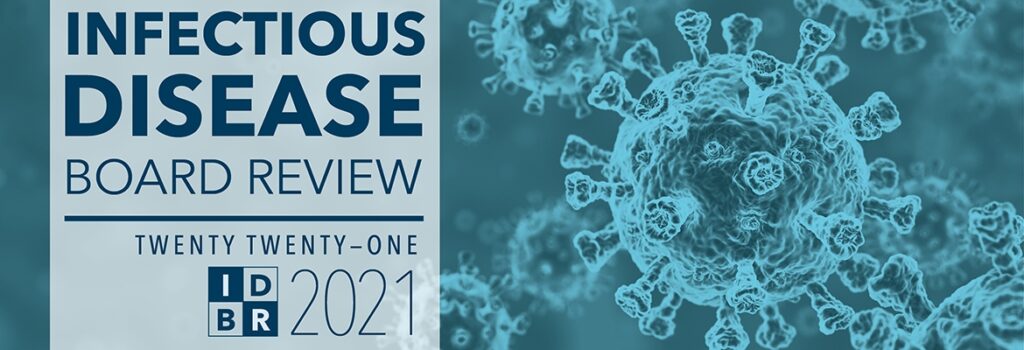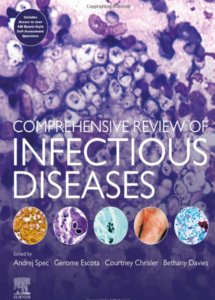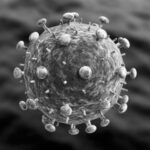Credits
Host: Sara Dong
Guest: Saira Butt
Writing/Producing/Editing/Cover Art/Infographics: Sara Dong
Dr. Saira Butt is an Assistant Professor of Clinical Medicine in the Division of Infectious Diseases at the Indiana University School of Medicine since 2016 and has served as the Program Director of the Adult Infectious Diseases fellowship-training program since 2018. She trained in infectious diseases at the University of Mississippi Medical Center. In addition to her efforts in the fellowship program, her education interests include curriculum development and the growth and development of learners as teachers. She contributes to infectious diseases medical education on twitter @sairabt and maintains social media content for the fellowship @iuidfellowship. She has won a teaching award for social media education at her institution. Her clinical interests are injection drug use-associated infective endocarditis, HIV, non-tuberculosis mycobacteria and medical education. She is a fellow of the American College of Physicians. She participates in Scotts County, Indiana’s HIV/HCV outreach clinics at their local health department and at the Scottsburg jail. She also maintains outpatient practices in both general infectious diseases and HIV care at the University Hospital, and she attends on the inpatient infectious diseases consult services at Methodist Hospital.
Culture
Saira likes to listen to audiobooks. A recent read she recommends is Something in the Water
Consult Notes
This episode covered some ID resources that you can use for board exam preparation or quick references! Here are the links to what we discussed (and a little more!) below
- You can find the recommended topics in the board exams at these links:
- First and most importantly – clinical care and day-to-day fellowship!
- Write down clinical pearls or learning points from your fellowship didactics and clinical rounds – you could use a notebook or I would plug posting #IDDailyPearl or #IDMedEd notes on twitter (it’s a nice way to get started on social media as well if you are not already!)
- Create and save your ddxs — sort why one thing against the other!
- George Washington ID Board Review Course
- Yearly course designed to prepare for ABIM ID exams
- Livestream course was completed already for 2021, but you can access the homestudy and online versions at the website
- There are great summary lectures, study primers, and several hundred MCQ

- We didn’t focus as much on textbooks during this episode, but do recommend this review book: Comprehensive Review of Infectious Diseases
- Released 2020 as a guide for high yield review of many ID topics.
- The ID associations and buzzwords resources are great!
- Plus there are several hundred MCQ that accompany the book and can be accessed online

- IDWeek has a Board Review Course every year that you can register for
- Board Vitals ID Board Exam Question Bank
- ID Fellows Cup
- Check out the sign-up link here and follow IDFC on twitter!
- This is a team-based competition that sends you board style questions via an awesome app. It’s open to ID fellows as well as others interested in ID
- With the explanations, you can find links to useful digital resources, guidelines, and more

- #IDTwitter
- #IDTwitter and #IDMedEd are great places to have board review pearls on your phone!
- Check out some of these great accounts: @IUIDfellowship @WuidQ @MayoClinicINFD and others!
- Use the UW National HIV Curriculum and the National STD Curriculum for review modules and great question banks!

- Have to plug Febrile podcast! Use the infographics to study or teach — or create your own and submit them to be added to the website!
- Check out the CDC DPDx Cases for great images and short clinical histories of parasites
- MassGen Brigham ID Images website also has short cases with great images, including prior IDWeek fellows day presentations. You have to join to access, but it’s free!
- UAB Gorgas Case of the week
- Have other resources? Send them in to be added
We covered a potpourri of brief cases in this episode. Check out the summaries below and in the infographics!!!
Eosinophilic meningitis
- Definition: >= 10 eosinophils/mm3 in CSF and/or >10% eosinophils in CSF
- The big 3 from the show (ABG) which can commonly present as eosinophilic meningitis
- Angiostrongylus cantonensis
- Most common parasitic cause of EM
- Rat lungworm: eggs laid by adult worms in pulmonary arteries or rates → migrate to pharynx and swallowed → passed in stool → larvae ingested by intermediate host (snail or slug) → mollusk ingested by rat, larvae migrate to brain and develop into adult worms, which return to venous system and pulmonary arteries
- Migrating larvae inherently neurotropic
- Southeast Asia, Pacific Islands including HI
- Humans acquire by eating raw or undercooked snails or slugs as well as infected animals (crab, freshwater shrimp, centipedes) → worms migrate to brain but do not produce eggs in humans
- Incubation period 1-3 wks
- Neurologic symptoms (transient meningitis, headache, etc), fever may be absent
- Tx: supportive. In absence of reinfection, larvae die in time
- Analgesics, steroids, and periodic removal of CSF can relieve symptoms related to elevated ICP
- Advise against antihelminthic agents, which may elicit inflammatory response to dying organisms
- Baylisascaris procyonis
- Migrating larvae inherently neurotropic
- Prevalent in US raccoons
- Adult worms shed eggs in raccoon or dog intestines → eggs become infected 2-4 wks in environment and ingested by raccoons, which hatch and penetrate gut wall
- Humans infected when ingest infective eggs from environment, often described as young child playing in dirt or sandbox (which raccoons use to latrine)
- Larvae can migrate through a variety of tissues, similar to toxocariasis, and impact eye (ocular larva migrans), organs (visceral larva migrans) or brain (neural larva migrans/eosinophilic meningitis)
- Tx: efficacy unclear and no meds indicated; but albendazole has been used
- Saira’s tip: might give clue related to raccoon feces (child in sandbox or homeless person)
- Gnathostoma spinigerum
- Migrating larvae in visceral, cutaneous, and/or neural tissues
- Endemic in Southeast Asia, China, Japan but occurs broadly in Europe, Central and South America, Africa, Middle East
- Adult worms lay eggs in definitive host (pigs, cats, dogs) → eggs passed in stool and embryonate in water → ingested by crustacean→ then ingested by fish, frog or snake (second intermediate host)–> then ingested by definitive host
- Humans acquire by ingesting undercooked intermediate hosts (fish, frog, snake for example) containing larvae or by drinking water containing infective second stage larvae Cyclops
- Triad: eosinophilia, migratory cutaneous nodules, raw fish consumption!
- Larval penetration into brain usually related to migration along nerve tract → so might have sudden onset severe radicular pain or headache; paresthesias; paralysis
- Tx: supportive
- Unclear if antihelminthic meds are beneficial, concern for harm with inflammation from dying larvae in CNS dz
- Cutaneous ghathostomiasis can be treated with albendazole or ivermectin as well as surgical excision of worms
- Angiostrongylus cantonensis
- Other less common causes to consider that might lead to eosinophilic meningitis:
- Coccidioidal meningitis; less commonly cryptococcosis
- Toxocariasis, neurocysticercosis, strongyloidiasis, trichinellosis, fascioliasis, Paragonimus westermani, echinococcosis, schistosomiasis, myiasis
- Non-ID: Hodgkins lymphoma, hypereosinophilic syndromes, adverse drug reactions, presence of VP shunt
- Check out some tweetorials/questions related to eosinophilic meningitis here:
Rabies!
- Only state that is rabies-free? Hawaii
- We spoke about rabies vaccine and rabies immunoglobulin recommendations, which are summarized below
- Rabies vaccine (give IM in deltoid; do NOT give in gluteal area because may result in lower antibody titers)
- Rabies pre-exposure prophylaxis
- Who should get pre-exposure rabies prophylaxis? Those at high risk for unrecognized or unrecognized exposures, such as live rabies virus researchers, persons who handle bats or at-risk animals for work, etc
- Recommended PrEP: Day 0, 7
- Check out these slides from the ACIP meeting from Feb 2021 that updated rabies PrEP recommendations
- Post-exposure rabies vaccine
- Recommended PEP: Day 0 (asap post-exposure), 3, 7, 14
- Since long latency period between exposure and onset of dz, PEP should be given regardless of length of delay (ideally give as quickly as possible)
- If received pre-exposure vaccine, should get 2 doses of PEP vaccine (day 0, 3)
- If immunocompromised, 5 doses of vaccine: 0, 3, 7, 14, 28
- Recommended PEP: Day 0 (asap post-exposure), 3, 7, 14
- You can find the Rabies ACIP vaccine recommendations online and in MMWR
- Vaccine induces antibodies in about 7-10 d and measurable Ab sticks around for several years
- Rabies pre-exposure prophylaxis
- Rabies immunoglobulin (HRIG) is given with post-exposure prophylaxis to provide immunity before vaccine response
- Clean wound with soap, water, and iodine solution if available
- Full dose (or as much of full dose as possible) should be infiltrated at site of bite/wound = 20 IU/kg body weight
- Any remaining dose should be given IM at a site distant from vaccine)
- If no obvious wound or bite, administer to anterolateral thigh or deltoid contralateral to vaccine dose (historically has been given into gluteus too)
- Give no later than 7d after vaccine series to prevent interference with vaccine effect
- If pre-vaccinated, no RIG
- Don’t forget about tetanus prophylaxis and antibiotics if indicated with wound
- When to use rabies prophylaxis?
- All patients with known or likely exposure to rabies should receive PEP. What is an exposure?
- Bite or saliva contaminated scratch/wound from an animal with rabies
- Open wound or mucous membrane exposure to saliva, CSF, or CNS tissue from animal with rabies
- NOT an exposure = normal skin in contact with saliva, neural tissue, blood, urine, feces, skunk spray
- Save your local public health recommendations to help frame risk assessment. You can review the algorithm on UpToDate as well for a general overview
- In US, if animal can be confined and observed for 10 days, can often delay decision on prophylaxis
- All patients with known or likely exposure to rabies should receive PEP. What is an exposure?
- Check out some tweetorials/questions related to rabies here:
Scombroid v. ciguatera poisoning
- You can find details in the table in the infographics
- Check out some tweetorials/questions related to scombroid and ciguatera here:
A few random associations we discussed on the show. Check out some of the resources, like the Comprehensive Review of ID book, for more!
- Armadillos
- Sporothrix schenckii
- Mycobacterium leprae: Saira’s tip – skin lesion might be subtle but no sensation in lesion → needs biopsy, which will demonstrate AFB
- Cats
- Check out Gerome’s mnemonic from Episode 2: My cat loves PPeanut BBuTTTer
- PP = plague (Yersinia pestis), Pasteurella
- B = Bartonella, Bordetella bronchiseptica
- TTT = tularemia, Toxoplasma, Toxocara cati
- Iguanas and reptiles
- Salmonella — might have stem with reptile pet and then GI illness → but remember vascular infection as well if patient is older
- Macaque monkeys
- Herpes B virus: usually will be clear in question, such as someone working in the lab
- Sheep
- Brucella
- Coxiella
- Orf virus
- Tick juice + Tularemia
- Parinaud oculoglandular syndrome: several causes but think about Bartonella and Tularemia in particular
- Near drowning + Scedosporium
- Tache noir and thinking about rickettsial infections based on location. These may present almost exactly the same but will need to use clues in exposures to determine
- Rash + eschar or tache noir + fever → vector borne
- Check out this nice summary of eschar-associated rickettsiosis from NCEZID
- R.parkeri (Spotted fever)
- US (Gulf Coast, mid-Atlantic)
- Vector: tick (Amblyomma maculatum)
- Fever, malaise, rash (disseminated, vesicular), black eschar at bite site
- Saira’s tip: think about this like mild RMSF but with an eschar
- R.akari (rickettsialpox)
- US (Northeast)
- Vector: house mite
- Fever, malaise, rash (disseminated, vesicular), black eschar at site of bite
- Saira’s tip: might be given person in major city with exposure to mites or homeless pt
- R.africae (African tick bite fever)
- Sub-Saharan Africa
- Vector: tick (Amblyomma spp)
- Febrile illness, headache, vesiculopapular rash, almost all with eschar at site of tick bite, often with lymphadenopathy
- Possible clue: Walking in wilderness areas in S.Africa or Zimbabwe; African safari
- R.conorii (Mediterranean spotted fever; Boutonneuse fever)
- Mediterranean
- Vector: tick (dog; Rhipicephalus)
- Fever, rash (sometimes purpuric), eschar, usually no lymphadenopathy
- Orientia tsutsugamushi (scrub typhus)
- Southeast Asia, Australia
- Vector: chigger
- Febrile illness, papular rash, eschar, lymphadenopathy
- Saira’s tip: knowing the vectors are important, particularly because you already know that treatment is doxycycline
- Some tweetorials/questions:
- R.parkeri:
- R.akari :
- R.africae
- R.conorii
- O.tsutsugamushi
Episode Art & Infographics
Goal
Listeners will be able to identify available ID board review resources.
Learning Objectives
After listening to this episode, listeners will be able to:
- Compare and contrast scombroid and ciguatera poisoning
- Utilize the recommended rabies pre-exposure and post-exposure prophylaxis regimens
- List the top 3 causes of eosinophilic meningitis
Disclosures
Our guest (Saira Butt) as well as Febrile podcast and hosts report no relevant financial disclosures
Citation
Butt, S., Dong, S. “#22: Microbe Mash”. Febrile: A Cultured Podcast. https://player.captivate.fm/episode/0d16383c-a666-4a8a-ace8-9ac004bbd088






